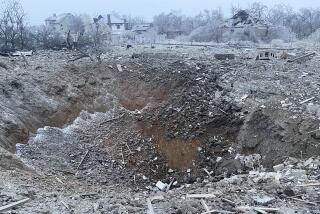Precision Is Crucial in Allied Attacks : Bosnia: The next phase of campaign, which poses risk of heavy civilian casualties, is likely to take more time.
- Share via
WASHINGTON — Allied commanders face a daunting challenge in the next phase of the air campaign over Bosnia: how to destroy Bosnian Serb artillery and tanks without killing hundreds of civilians.
Military analysts said Wednesday that the targets destroyed by North Atlantic Treaty Organization warplanes so far have been the easy ones--Bosnian Serb air-defense batteries, communications centers and radar sites--that are largely isolated from populated areas.
But hitting individual artillery pieces and tanks is decidedly more difficult--especially around Sarajevo, the capital, and other urban areas, where such weapons can be repositioned near factories, homes and schools.
Moreover, for all the allies’ boasts of having precision-guided munitions that can pinpoint targets precisely, there are wide variations in their effectiveness.
For example, the aircraft of most NATO allies--even those whose forces are equipped with U.S.-made warplanes, such as the F-16--do not carry the capability to use laser-guided munitions.
And military officers said the latest bomb-damage assessments show that the laser-guided weapons systems being used by some U.S. warplanes were less effective in the initial phases of the operation than had been thought.
Partly as a result, they said, Air Force officials are considering whether to press for more U.S. F-16s and F-15s--which are capable of carrying precision-guided munitions--to help increase the accuracy of each of the allied sorties.
Strategists also have ordered in AC-130H Spectre gunships, equipped with precision-guided 105-millimeter howitzers and 40-millimeter cannon that are especially accurate in such situations.
The problem, analysts said, is that Aviano air base in Italy--the principal launching point for land-based NATO aircraft participating in the air strikes--already is operating near capacity and is unable to handle many more planes.
And for all the proven effectiveness of the AC-130H, it is unusually slow-moving and vulnerable to attack by ground-fired missiles. Such aircraft would need protection wherever they went.
NATO commanders also are expected to direct their air strikes against targets in other parts of Bosnia-Herzegovina that so far have been untouched by aerial attack such as the northern and northwestern parts of the country.
Defense experts both in and outside the Pentagon predicted that a shift to more densely populated areas is bound to slow the speed of the overall air operation’s pace.
“What this is telling me is that this second phase is going to take a relatively longer time than the initial series of air strikes did,” said Robert W. Gaskin, a former Pentagon planner.
A senior military officer who has participated in the planning for the Bosnia operation agreed. The next round of air strikes will involve more difficult targets and a greater danger of unintended damage, he said.
Also a problem is the region’s often-cited bad weather, which already has impeded some air operations. NATO had been prepared to resume its air strikes earlier than Tuesday morning but was held back by fog.
Col. James E. Cartwright, commanding officer of Marine Air Group 31, which is participating in the current air operations, said that flying high or low enough to accommodate the weather can seriously impede a pilot.
“If you have to drop down too low to where you really can get your eye on a target, you’re vulnerable to ground fire,” he said.
There was some dispute here Wednesday about whether the Navy’s precision-guided weapons system, known as Nighthawk, is as accurate as the Air Force Low-Altitude Targeting Infra-Red system.
Some analysts contended that bomb-damage reports showed the Navy’s attack planes hit only about 40% of their targets during initial phases of the bombing, while the Air Force system destroyed 80%.
But Navy spokesmen disputed that, saying that the percentages varied sharply with the size and type of target. “The Navy didn’t do well the first night in” one official conceded, but said that after that it “did better.”
More to Read
Sign up for Essential California
The most important California stories and recommendations in your inbox every morning.
You may occasionally receive promotional content from the Los Angeles Times.













